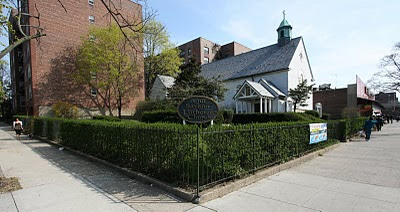- How was Rego Park named?
- Between all the bustle of Queens Blvd, where is Rego Park's history?
- What can we do as citizens to preserve our neighborhood from insensitive alterations and demolition? Are there any benefits?
What Rego Park has to offer in the name of history is directly in front of our eyes, but for some residents and passersby, it can be a needle in a haystack, so we have to be informed........
Rego Park was named in 1923 by developers Henry Schloh and Charles Hausmann of the “Real Good” Construction Co, after buying farmland. The land was once part of Forest Hills, which was named in 1906, but changed for real estate purposes. The first developments included 525 8-room Colonial houses bordering 63rd Dr and Elliot Ave, followed by elaborate apartment houses on Saunders St in the late 1920s, which continued through the 1940s on Saunders St and Queens Blvd, and were also highly regarded. A large quantity of the original homes stand today in a relatively unaltered state, and the apartment houses remain mostly intact. The first street was Remsen Ave (now 63rd Drive), named after the Remsen family, which owned a large parcel of farmland in Rego Park, which is difficult to visualize today.
Some other notable sites that are reflective of Rego Park's historic fabric include Public School 139 on 63rd Dr, which was filed with the Dept of Buildings in 1928, Lutheran Church of Our Saviour, which opened its first formal home in 1931 on 63rd Dr, and Rego Park Jewish Center on Queens Blvd with a cornerstone reading 1948 (Placed on the State & National Register of Historic Places in Oct. 2009), and the Lost Battalion Hall on the north side of Queens Blvd between 63rd Dr & Horace Harding. In the late 1930s and throughout the 1940s, classic Art Deco shops were erected on Queens Blvd and along 63rd Dr, and some were considered showrooms for goods, with customers appreciative of their mom & pop status and revolutionary architectural touches.
Remo Hall, erected 1927, is the earliest apartment house in Rego Park on Saunders St. It is a Tudor architectural gem alongside neighboring buildings that exhibit a smorgasbord of styles in our neighborhood, including Georgian Colonial, Art Deco, Moorish, and Medieval. Other historic apartment houses include Marion Court, Jupiter Court, Savoy Gardens, Elizabeth & Victoria complex, and the Oxford and Cambridge complex, and the the Saunders Gardens complex, which were all developed from the late 1920s - early 1940s. Many apartment houses are symbolic of Ebenezer Howard's Garden City Movement, since they grant a sense of place by reserving space for landscaping and breathing space by not developing the land in its entirety, have recessed building wings, feature courtyards, are low-rise in scale, feature roof gardens for residents to associate and keep cool during the summer months, and most incorporate traditional English architectural touches. Even though the Saunders Gardens complex is a later addition with Art Deco touches, it features recessed areas and the traditional roof garden, along the lines of Marion Court, and was developed around the central theme of a park.
The architectural and cultural diversity within a concentrated section of the neighborhood, sheds lots of history, and therefore merits preservation within a Rego Park Historic District by the NYC Landmarks Preservation Commission (http://www.nyc.gov/html/lpc/html/home/home.shtml). The general boundaries are inclusive of Queens Blvd, 63rd Dr, Saunders St, and Elliot Ave, and touch upon Booth St and Wetherole St. Rego-Forest Preservation Council has been documenting and researching this section of the neighborhood (and other sections of both Rego Park and Forest Hills) for nearly 2 years. This is much-needed, and will ensure survival of its historic and harmonious character, ensure that any future development is in context, and will maintain and enhance property values over time. NYC Landmarking (sometimes in combination with State & National Register of Historic Places status) also increases the likelihood of acquiring grants for property owners, through funding programs for historically-sensitive restoration work and building upgrades.
This is a collection of Saunders St, Queens Blvd, & 63rd Dr photos by Chair Michael Perlman of Rego-Forest Preservation Council: http://www.flickr.com/photos/8095451@N08/collections/72157617606028777/
This is a work-in-progress! Please browse and become our flickr friend and a supporter throughout the research process. E-mail unlockthevault@hotmail.com with questions, suggestions, or to become a preservation supporter. All contributors will be recognized.






























Rego Park has some breathtaking works of architecture in comparison to the landscape, and its history is unique. Historic buildings with court yards and roof gardens are rare. A historic district for a section of Rego Park is the way to go.
ReplyDelete